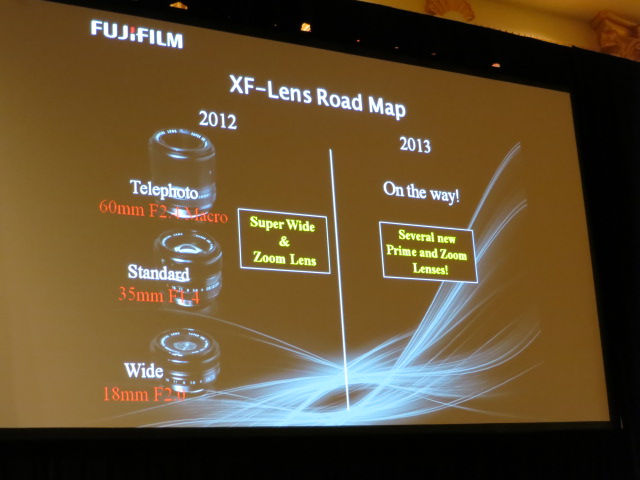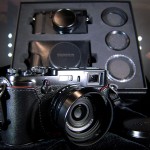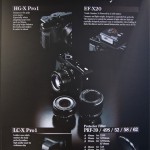I finally got to get some hands-on time with the new Fuji X-Pro1 at CES 2012. After handing out Camera of the Year honors in 2011 to the Fuji X100, I’ve been itching to see what Fuji had coming for the oft-rumored interchangeable lens lineup. Based on what I’ve seen so far, the Fuji X-Pro1 looks like it won’t disappoint and should easily be in the running for the 2012 Camera of the Year.

The X-Pro1 has all the class and build-quality that we’ve come to expect from the X-series. As was the case with the X100, the smart aperture ring and shutter dial makes manual and auto operation a breeze.
At 16MP, the X-Pro1 appears to offer solid (if not class-leading) image quality and high ISO performance for an APS-C format camera. The form-factor is gorgeous and feels great in the hand. It has all the deliciousness of the X100’s body and adds a world of potential with interchangeable lenses.
The only downside that I see thus far (as compared to the X100) is the focal plane shutter, which offers sync speeds of 1/125s. The X100 synced at 1/4000s thanks to its leaf shutter. My guess is that adding a leaf shutter to each lens for the X-Pro1 would have been cost prohibitive – since they currently run $600 each anyway.
The X-Pro1 does offer TTL compatibility with Fuji’s new line of hotshoe flashes. Sadly though, there is currently no wireless TTL built into the system. I’m not sure if a third party could hack something together, but it could be an exciting workaround if they did.
Listening to Fuji’s press conference (full video here), I was a bit skeptical about their intended market for the X-Pro1 as a mainstream portrait and wedding camera. However, after handling the camera and getting a glimpse at the solid image quality it delivers, I’m less so now. I’m not ready to sell off my 5D Mark II but I wouldn’t be at all surprised to see these show up on real shoots over the next few months.
The AF seems fast and snappy. And the overall performance of the camera is as fast as you would expect from a pro-level camera.

As far as lenses go, Fuji is out of the gate with a trio of prime lenses: an 18mm f/2.0, a 35mm f/1.4 and a 60mm f/2.1 Macro. A super-wide 14mm lens and a zoom lens are slated for release later in 2012, and several new prime and zoom lenses should be in the lineup in 2013. I would expect to hear more big news on the X-Pro series cameras and lenses by the time Photokina 2012 rolls around in September.
Initial pricing on the body is estimated at $1700 and $600 for each of the three primes. While several folks have balked at these prices, I think Fuji is going to have a hard time keeping them in stock even at that.
Frankly, the Fuji X-Pro1 looks and feels awesome. Performance seems to be most of what we’d hoped for – save for the focal plane shutter, 1/125s flash sync and limited TTL system. Image quality looks stunning based on what I’ve seen thus far. I can’t wait to spend more time with a production model.
The X-Pro1 should be available in February 2012. Check availability at B&H Photo.
By making your photography purchases through these links, you are helping Photography Bay to continue bring quality camera tests, news and reviews. Thanks for your continued support.
- Fuji X-Pro1















hi, I am really interested in AF performance,
can you write some more details?
Compared to a reflex or Olympus Pen ep3 performance how does it work?
Thanks in advance!
Matteo
Sorry but this is really a ugly camera, like back in the sixties.
That’s point. Retro look like the other X series cameras.
How dumb do you have to be to buy a camera based on how it looks? (It looks great, by the way).
I have a russian Zorki 4 ( made in 1962 ) in my attic and, after 50 years, it looks far better than this “artefact”. How could you ever think of selling off your 5D Mark II ? It looks to me as being designed by Louis Lumiere or George Eastman, back in 1900…1920. Frankly, I wouldn’t spend 10 EUR on it. Just try to imagine yourself taking photographs in Paris at Tour Eiffel with this oldtimer. Brrrrr !
I am surprised Fuji left Vibration Reduction or Image Stabilisation out of this camera. Most other makers claim a 2-4 stop improvement from this technology which compensates for smaller aperture lenses. I don’t mind the return to a focal plane shutter as long as it is quiet. My Nikons are way too noisy.
I will stick with my Nikon heavy iron for ‘serious’ stage and portrait shots and my Fuji x-10 for everyday shots. I will sit out the X-Pro1 and wait for the successor with image stabilisation.
Brian
I think that a new mirrorless system camera is more likely to be bought by people who are starting. And then this system camera is a nice new chose, but in my opinion a little expensive. The Sony Nex seems to have the best offer. Like mihai says “How could you ever think of selling off your 5D Mark II ?” and all my Canon lenses for that matter. No way Jose. I am happy with the system I have and a small compact to go along. In my case the Sigma DP2. And I like to see all the new camera’s coming out and the chose begins to look like the good old analogue days.
While I think this camera looks promising and I’m definitely drawn to it’s styling and small form factor, I think Fuji is extremely ambitious with their pricing. For about the same price, you could get a Canon 5D Mark II, 28/1.8 USM, 50/1.4 USM and 85/1.8 USM. Add another $100 and you can get an extension tube to give your 50 and 85 macro capabilities.
This camera is essentially an Enthusiast camera. I think their prices are at least 100% higher than they should be. I could see $700 for the body and $250-450 for the lenses. And that is on the high end.
When the X100 came out, I thought it might be just the camera I had been waiting for. Something small, light and unobtrusive to carry with me. Something intuitive. But the price point puts it WAY out of my reach. There are far better alternatives and Fuji should check their aggressive pricing before releasing another system.
I agree with you here for the most part on the pricing. But, even the NEX-7 comes close to the same price point when using one of its quality lenses.
Although I was really looking forward to grabbing this as my walk round camera I think I will go with the X100 for now.
I can’t wait to see what fuji comes out with in the future though. They are really raising the bar compared to many manufacturers.
Agree that the camera is currently overpriced. Disagree with your judgement of where it should be.
The Fuji is not competing with entry level dslrs, or viewfinder-less 4/3 cameras. It’s competing at the prosumer/pro level, at least with cameras like the Nikon D7000 and Canon 7d. That would put a competitive price somewhere around $1200 – $1500.
As for the lenses, look at m4/3 primes. They range from around $300 to almost $1000, and the ones at the lower end tend to be f2.8. The Fujis are all faster, and APS-C lenses are larger and more expensive than 4/3. Plus, Fujinons are high-end lenses that have always compared well with Zeiss and Leica.
Add in the fact that they are the only “rangefinder” game in town, and that they will sell a bunch at the beginning regardless of price, and their starting price makes some sense.
If it begins to meet price resistance after 6 months or so, they may drop to something more realistic. (But never to $700)
Oh, and notice that the X100 is still selling for $1200, a year after release. If they weren’t selling enough, Fuji would have dropped the price, and there’s no way the XPro-1 will ever be cheaper than the X100.
Yes readers, Please do make your purchases through the links on this site! We should help support Photography Bay so that they can continue to give us so much valued information.
Regarding the Fujifilm X Pro 1 however, please try to control your urge as expensive does not always equal value and precision. When (and if) all the bugs are worked out of this camera, and the prices for all the individual components are brought down to earth, and one can afford the three lenses, the case and the small flash unit, (a Zoom lens is planned for the future) Then we can re evaluate the system as a complete set, as that is what’s needed. At this time, only the wide angle lens is available. But please read this preliminary review, and the others before handing over your credit card. (Note: If the zoom came out now, we might make a different choice when evaluating the Prime lenses)
There will be other reviews out soon and you may not approve everything that you read. As of late, Fujifilm seems to be hiding behind their high prices and assuming that we will buy what ever they allow us to purchase! Although we feel so honored to be allowed to purchase such “Fine precision” instruments, lets not forget Fuji’s behavior of late, instead of fixing it, they come out with the next version ex.: HS10, HS20, HS25, HS30 EXR. The last three in just over a year! Do you see the trend? Even this, with only what they want us to see! I applaud them, for being Pioneers, but it’s the Pioneers who are hit with the arrows first, it is the ones that come after that succeed, after they see, and correct the mistakes! Let us not forget, that fuel for our cars is now approaching $5.00 per gallon!
Hey guys, One thing that I wanted to mention about The Fuji X PRO 1 & I didn’t see it here at all yet. On, or in, the first “FUJI GUYS” video, which only included Billy (did you see him fumbling with the Body cover and lens covers). The body cover spun around a bit, but when he put the 60MM lens down without the cover on the back, he quickly picked up the lens and put the cover on it right away. I mention this because we see very little of the rear elements of the two lenses that are in the short videos and I have a feeling that the rear element of the lens sticks out past any part of the lens housing. The reason may be because the rear element reaches into the camera body, like is seen sometimes with Fish Eye Lenses. If thats the case, the lens cover should always be put on the rear of the lens when it’s laid on it’s rear. With internal focusing this sometimes happens and it’s way too easy to damage the rear element or the aperture lever, contacts or anything else there that’s vulnerable.
But what I wanted to mention here is that on the video, Billy says “You should try to get a an SDHC Card with at least a (6) rating, “So it will be fast enough” Actually, with most every camera made recently, they recommend a card with a (10) speed rating, the reason is, so the card is fast enough to “Buffer” and “Save” the images, so you can keep shooting. Saying that only a (6) rating is needed is admitting that it just doesn’t go through the process fast enough (Shoot, Buffer, Save & Ready). With most every other camera, we all use a (10) rating. So along with slow focusing and slow at saving images, we do get to save a little money on some of our SDHC cards. (sarcas.). In Billy’s defense, he did the video by himself, But I don’t know what it was recorded with. Don’t forget, Buyer Beware! . .. Cheers …… Joe Prete